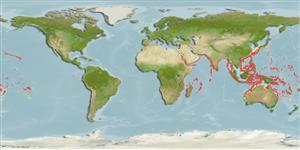Common names from other countries
>
Eupercaria/misc (Various families in series Eupercaria) >
Lutjanidae (Snappers) > Etelinae
Etymology: Pristipomoides: Greek, pristis = saw + Greek, poma, -atos = cover, operculum + Greek, oides = similar to (Ref. 45335).
More on author: Bleeker.
Environment: milieu / climate zone / depth range / distribution range
Ekologi
laut bentopelagis; kisaran kedalaman 100 - 360 m (Ref. 9821). Deep-water; 35°N - 32°S, 30°E - 143°W (Ref. 55)
Indo-Pacific: East Africa to Hawaii, and northward to southern Japan. A single specimen, apparently of this species, obtained from Vema Seamount in the southeast Atlantic.
Size / Weight / umur
Maturity: Lm ? range ? - ? cm
Max length : 79.0 cm TL jantan/; (Ref. 40637); common length : 40.0 cm TL jantan/; (Ref. 30573); Berat maksimum terpublikasi: 8.4 kg (Ref. 40637)
Duri punggung (Keseluruhan (total)) : 10; duri punggung lunak (Keseluruhan (total)) : 11; Duri dubur: 3; Sirip dubur lunak: 8. Interorbital space flat. Lower jaw slightly protruding. Bases of dorsal and anal fins without scales, their last soft rays extended into short filaments. Pectoral fins long, reaching level of anus. Scale rows on back parallel to lateral line. Body is silvery with lavender hue; the top of the head with dark spots; margin of the dorsal fin orange; the caudal fin purplish with the inner margin of the fork pale.
Adults are found over rocky bottoms (Ref. 30573); off Guam, caught most abundantly from about 180 to 270 m (Ref. 9821). They feed mainly on fishes, shrimps, crabs, polychaetes, cephalopods and urochordates. Marketed mostly fresh. Caught mainly with bottom longlines and deep handlines.
Life cycle and mating behavior
Maturities | Reproduksi, perkembang biakan | Spawnings | Egg(s) | Fecundities | Larva
Allen, G.R., 1985. FAO Species Catalogue. Vol. 6. Snappers of the world. An annotated and illustrated catalogue of lutjanid species known to date. FAO Fish. Synop. 125(6):208 p. Rome: FAO. (Ref. 55)
Status IUCN Red List (Ref. 130435)
CITES (Ref. 128078)
Not Evaluated
ancaman kepada manusia
Harmless
penggunaan manusia
Perikanan: komersial; Ikan buruan: ya
Alat, peralatan
laporan khas
muat turun XML
Sumber internet
Estimates based on models
Preferred temperature (Ref.
115969): 13.8 - 23.1, mean 18.2 (based on 265 cells).
Phylogenetic diversity index (Ref.
82804): PD
50 = 0.5005 [Uniqueness, from 0.5 = low to 2.0 = high].
Bayesian length-weight: a=0.01445 (0.00833 - 0.02507), b=2.99 (2.84 - 3.14), in cm Total Length, based on LWR estimates for this species & Genus-body shape (Ref.
93245).
Trophic level (Ref.
69278): 3.7 ±0.2 se; based on diet studies.
Daya lenting (Ref.
120179): sedang, Waktu penggandaan populasi minimum 1.4 - 4.4 tahun (K=0.3).
Fishing Vulnerability (Ref.
59153): Moderate vulnerability (36 of 100).
